Elizabeth Minchilli's Blog, page 8
January 20, 2021
Thai Coconut Curry Soup

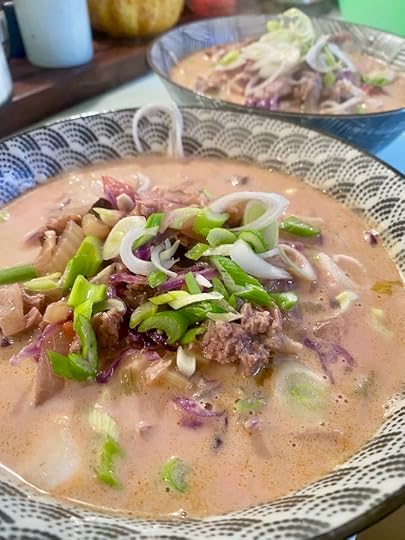
I don’t always eat Italian food. In fact, when I’m cooking at home for myself and Domenico, I cook a lot of food inspired by my cupboard full of ingredients from Asia and the Middle East. Last night I made a soup that was more or less a version of Thai coconut curry soup, which Sophie makes all the time. So this is basically her recipe, if you can even call it a recipe. Truly, once you have the basics down, you can spin it any way you want.
The two main ingredients that are non-negotiable are:
-Coconut Milk
-Thai Curry Paste
If you’ve never used Thai Curry Paste, it a pre-made mix of spices including hot peppers, coriander, cumin, cardamom , lemon grass, garlic and galangal. It usually comes in three varieties: Red, Yellow and Green. They vary slightly from color to color and brand to brand, but you can try them and see which you like best. I tend to like the slightly milder green, but all I had last night was the red which I also love, even if it’s a bit spicier.
Although I used some frozen vegetable broth I had in the freezer, you can also use just water.
Vegetables: Any will do! This is the time to use up that half a red pepper you kept, or that one lonely zucchini. I happened to have a bit of red cabbage so used that.
Starch: I used rice noodles last night, but leftover rice will do or even regular spaghetti.
Meat or fish: Although not at all necessary, I do like adding just a bit of meat or fish. Last night I had some leftover barbecued ribs so ended up with a half cup of cooked pork. This is the perfect place to use the rest of that rotisserie chicken. Or if you have frozen shrimp in the freezer you can pop those in frozen and they will cook in a few minutes. Also good? Ham or even a fried egg at the end.
I’m sure my mother would call this ‘clean out the fridge soup’ but since my mother would never had Thai Curry Paste or Coconut milk in her pantry, let’s just stick with Thai Curry Coconut Soup and pretend we actually had a plan.
PrintThai Coconut Curry SoupYield 2
Ingredients3 tablespoons oil (I use olive oil, because it’s what I have, but peanut or corn oil is fine)1 medium onion1 tablespoon chopped ginger1/2 tsp salt1 clove garlic, chopped1 Tablespoon of Thai Curry Paste (or more to taste, it’s usually spicy so taste it first)2 stalks celery, chopped1 large carrot, chopped1 tomato, chopped1 1/2 cups shredded cabbage2 cups vegetable broth or water1 can full fat unsweetened coconut milk1 tablespoon Thai fish sauce1/2 cup shredded cooked pork (or any other meat or fish)3 cups cooked rice noodles2 chopped scallionsfresh lemon juice to tasteParsley or Coriander (optional)InstructionsHeat the oil in pan and add the onion and ginger and salt. Cook over medium heat until onion is soft, about 5 minutes.Add the garlic and Curry Paste. Stir and cook until the garlic is fragrant, about 3 minutes. Add all of the vegetables and stir well. Let cook another 5 minutes then add the broth or water, the coconut milk , meat and the fish sauce. Bring to a simmer and cook for 8 minutes.To serve:Divide the noodles into two large bowls. Ladle the soup on top of the noodles. Top with scallion and squeeze lemon juice over to taste. Parsley or coriander is nice if you have it (I didn’t ) If you like it spicy add hot sauce of your choice.The post Thai Coconut Curry Soup appeared first on Elizabeth Minchilli.


January 14, 2021
Radicchio Recipes

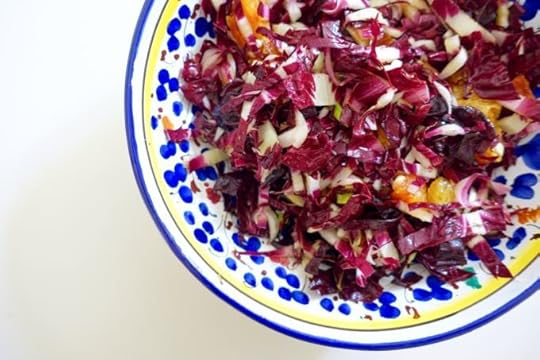
If you follow me on Instagram then you know that I’ve been eating a lot of radicchio lately. First up was radicchio from our own garden. It was satisfying beyond words to plant, grow, harvest and then gobble up our crop. Now that we’re back in Rome I’m relying on the Farmer’s Market to provide my fix. Because come this time of year the slightly bitter, crispy leafy vegetable is what I crave. And you must too, since you’ve been asking for radicchio recipes.
A lot of people think they don’t like radicchio. But chances are that the only radicchio they’ve ever tried is a variety called Radicchio di Chioggia. Those are the deep burgundy, very tight heads that are usually available all year round in your local supermarket. I have to say that for the most part, I try to avoid them. They are intensely bitter, and also slightly tough. I much prefer other varieties like Treviso Tardivo, with it’s curly cue ends; Castelfranco with it’s speckled leaves; and Treviso which kind of tastes and looks like wine colored endive. But in a pinch, I’ll definitely devour a head of Chioggia.
Even if you’re not a radicchio expert, at the very least you’ve probably come across some sort of raw radicchio leaf in a mixed salad.But when I make a radicchio salad I use the entire head, making it all about the radicchio. While other types of endive (Radicchio is actually a type of endive) like puntarelle or curly endive call for strong garlicky or anchovy laden dressing, I like to pair the bitter radicchio leaves with something sweet. Fruit for sure, fresh or dried, and this is the one salad where I welcome the sweet/sour addition of balsamic vinegar.
Did you know that radicchio even better cooked? The bitterness is tamed slightly and pairs perfectly with cheese or grilled meats.
And of course radicchio makes the perfect topping for creamy starchy pasta or risotto. In fact, I’m about to leave my office to go to the kitchen to make a video of one of my favorite quick lunches, Pasta with Radicchio and Blue Cheese. Sorry no recipe yet! But it will be up on IGTV soon.
But I do have tons of other great (and easy!) radicchio recipes that should satisfy your cravings in the meantime.
Radicchio and Tuna Pasta
Radicchio and Blood Orange Salad
Radicchio and Blue Cheese Salad
Radicchio and Pear Salad
Radicchio Risotto
Roasted Radicchio and Pine Nuts
Roasted Radicchio and Cured Pork
Radicchio Salad with Guanciale Dressing
Radicchio, Pear and Walnut Salad
Too Pretty To Eat Radicchio Salad

Radicchio di Treviso

Radicchio di Treviso

Radicchio di Treviso

Radicchio Tardivo di Treviso

Radicchio di Castelfranco

Radicchio di Chioggia
You can find more recipes in my books, The Italian Table, and Eating Rome.
If you’d like to join me in Italy we’ll be cooking and eating dishes like this during our Food Tours we have planned. You can find more information, including the dates, here.
Have you signed up for my Premium Newsletter yet?
The post Radicchio Recipes appeared first on Elizabeth Minchilli.


January 3, 2021
Tortellini in Brodo
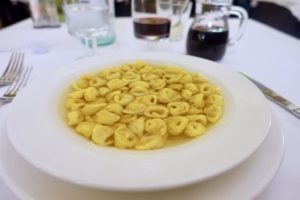
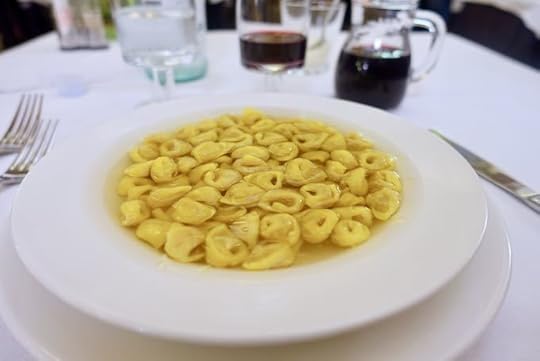
If you follow me on social media then you know that almost every Christmas day we have tortellini in brodo. Small rounds of stuffed pasta floating in a clear, rich broth. A hefty dusting of grated Parmigiano Reggiano and it’s pure heaven.
You are also probably one of the many people who have asked me for the recipe for this dish. So finally here it is, the post you’ve all been waiting for: the recipe for Tortellini in Brodo.
Or, rather, how I bring Tortellini in Brodo to our table.
The first big reveal is that I NEVER EVER make my own tortellini. Sorry. Just not happening. I’ve taken many lessons, made videos, eaten, watched and learned. But at the end of the day I’m very happy to farm this part of the recipe out to one of the many excellent fresh pasta makers in Rome, Umbria or Bari where we usually spend Christmas.
But since you may not be as lucky as I am, with pasta makers at your beck and call, I’m including a recipe below. This recipe was shared by Marisa who owns the hotel Zoello Je Suis just outside of Modena. She is known as one of the best tortellini makers in an area known for its tortellini so that’s saying something. You can see a video of her making tortellini here and read all about her in chapter 4 of my book Eating My Way Through Italy.
It’s definitely a recipe that requires dedication. And practice. I’d suggest watching as many videos showing how to form the little shapes as possible WAY before you plan to serve this to guests.
The brodo part of the equation is a bit easier. Like MUCH easier. Because my little secret to perfect rich clear broth is using an Instant Pot. Feel free to make your own broth any way you’d like, but I can safely say that even if you only ever use your Instant Pot to make broth, it’s worth the investment and counter space.
But even if you don’t use an Instant Pot, and you definitely can do this on top of the store, please please please make your own broth. This dish is ALL about the brodo, so no ready made store bought. Sorry. That’s my final word.
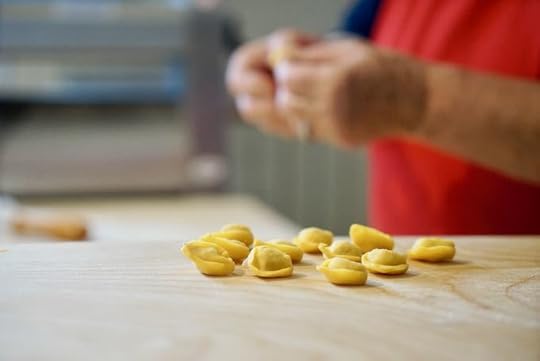
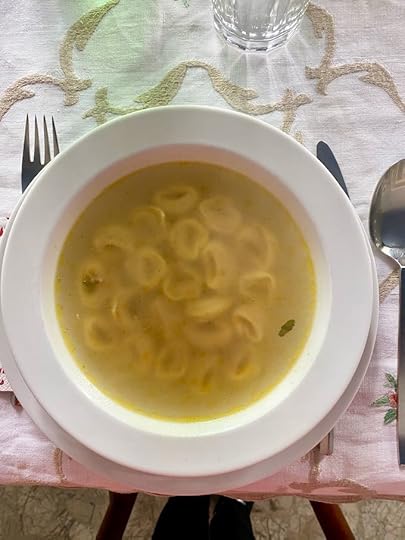
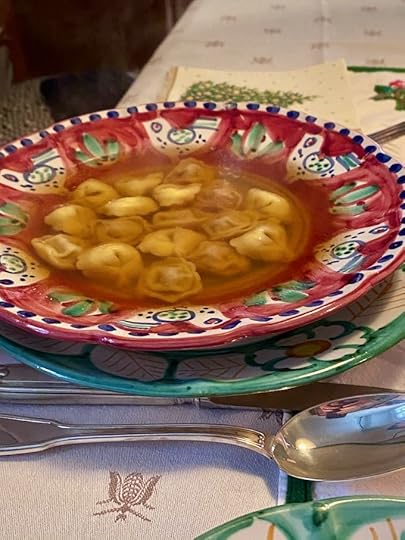
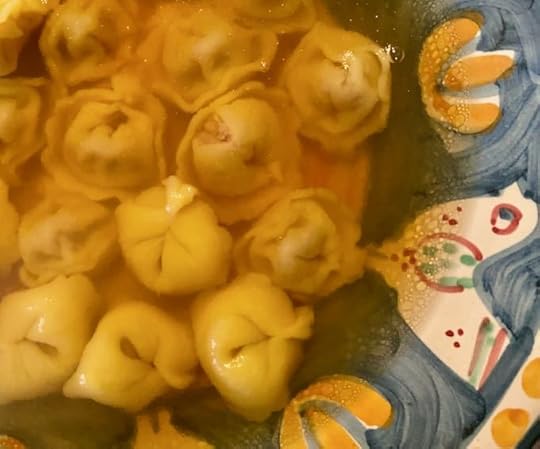
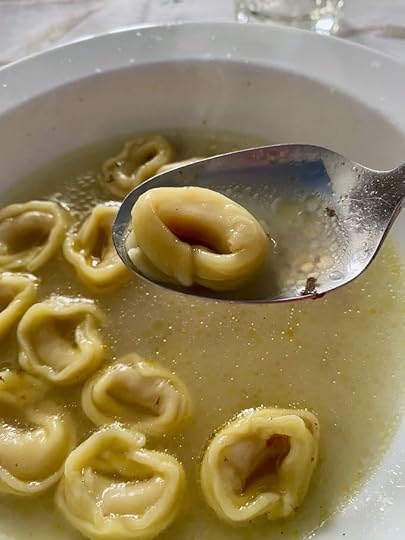
Instant Pot Brodo
1/2 chicken or capon, cut into 2 pieces
1 piece of beef (about 1 pound)
1 beef bone from the butcher
1 stalk celery
1 carrot
1 onion
2 cloves garlic
1 tsp whole black pepper
1 bay leaf
a few sprigs of parsley
1 tablespoon of course salt
Place everything in the Instant Pot. Cover with water up to the line on the inside of the pot, about 2/3 of the way up. Close the pot and close the valve shut. Cook on high for 3 hours. Let it release naturally. Open and strain. It’s best if you leave it overnight in the refrigerator. That way, the next day once it is chilled, you can carefully remove the fat that has congealed on top. It will be the best brodo you’ve ever had. Promise.
Tortellini
Yield 8
The flavor of tortellini comes from a mixture of meats. Everyone has their own secret recipe, for both the filling and for the broth. This is the recipe that I learned from Marisa at Zoello Je Suis Hotel. It differs from traditional recipes in a few ways. Rather than use prosciutto, Marisa prefers culatello. And In addition to pork, she also uses a bit of beef as well as some sausage. Although she let me watch her make it, she refused to give me exact quantities. “I have to have some secrets!” she said.
This recipe is taken from my book Eating My Way Through Italy. If you’d like to know the full story Marisa, whose recipe this is, see chapter four
Ingredients
For the filling:
60 grams Mortadella
60 grams Cutatello
120 grams grated Parmigiano – 30 mesi
50 grams beef round, but in cubes
100 grams pork loin, cut in cubes
1 sausage
nutmeg
salt
pepper
For the pasta:
800 grams “00” flour
8 eggs
Instructions
To make the filling:
Place the cut up meat and sausage in a pan and cook until done and well browned. According to Marisa, the meat should ‘sing’ and that’s when you know it’s done. Let the meat cool off completely, then put it in a food processor or grinder with the mortadella, culatello. Process until completely blended. Add the cheese and mix well, along with the nutmeg, salt and pepper. Let cool, and refrigerate over night.
To Make the Pasta:
Mix the eggs and the flour together, and knead until the dough is silky and smooth. Let rest, wrapped in plastic, for an hour. When ready to form tortellini roll out the dough with a rolling pin or pasta machine to the finest setting.
Using a knife cut the dough into 3-4 centimeter squares. Using your fingers, place a tiny bit of filling in the center of the square. Close the square to make a triangle, making sure the edges are well sealed. Then, using your little finger in the center, bring the two lateral corners to meet up, pinching them together, while leaving space in the middle where your finger was, forming a little navel shaped pasta. Repeat a million times until you’ve used up all the pasta and filling.
To serve, cook in drained broth, for about 4 minutes. Serve with abundant grated Parmigiano Reggiano.
This recipe is an excerpt from my book Eating My Way Through Italy You can find more recipes in my books, The Italian Table, and Eating Rome.
If you’d like to join me in Italy we’ll be cooking and eating dishes like this during our tFood Tours we have planned. You can find more information, including the dates, here.
The post Tortellini in Brodo appeared first on Elizabeth Minchilli.


December 15, 2020
Pork Tenderloin with Hazelnuts

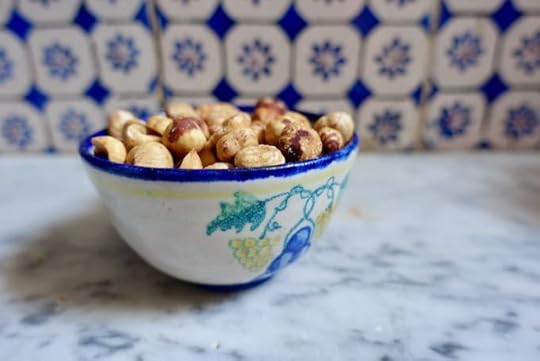
Are you trying to figure out what to make for Christmas or New Year’s this year? Somehow planning out menus for holidays is always stressful, even for me. And I kind of do it for a living. And this year seems even more difficult. First of all , like everyone else, there is the fact that I have been cooking non-stop and am having a hard time thinking up something new and fun and dare I say festive?
Here in Italy there are some holiday givens. I know we’ll be having fish on Christmas Eve. And Christmas day will most likely be tortellini in brodo. But what about the main course on Christmas day? Or New Years?
And then I remembered a recipe that I included in The Italian Table. It ticks all the boxes: easy, different and kind of fancy.
I first had Pork Tenderloin with Hazelnuts at a lunch given by a princess in the garden at her castle outside of Rome. I’m not making that up. So I think the pedigree itself makes the dish kind of celebratory. But also the fact that it’s definitely on the rich side makes it the perfect cold weather holiday fare. And since it uses a cut of meat – pork tenderloin – that is on the smallish size, I’m thinking that it will also be perfect for a holiday meal that this year may only be for one or two people?
The countryside in the area of Lazio near Viterbo, where the castle is located, is covered with groves of hazelnuts, which tend to make their way into many dishes, including this main course. The pork tenderloin is cooked first and then briefly reheated in a rich sauce of hazelnuts, milk and stracchino cheese. Stracchino is the secret ingredient, and what gives the sauce its rich and tangy creaminess. This cheese is also called crescenza and usually comes pre-packaged. If you can’t find stracchino or crescenza, you can substitute mascarpone.
If there is one drawback to this recipe, it is how it looks. If you are searching for some sort of impressive glistening roast piece of meat then this is not the recipe for you. If, on the other hand, you don’t mind a pile of perfectly cooked sliced pork, covered in a kind of beige , but completely luscious and slightly decadent sauce, then buon appetito!
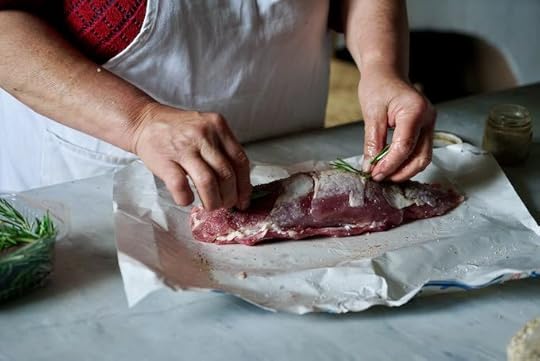
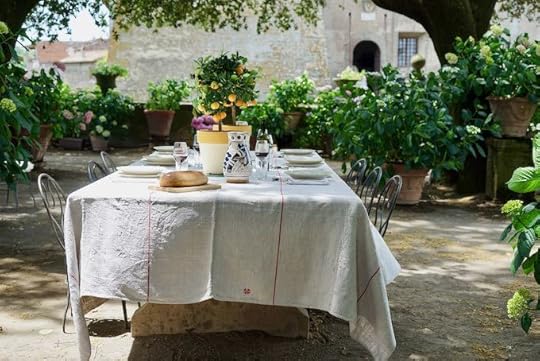
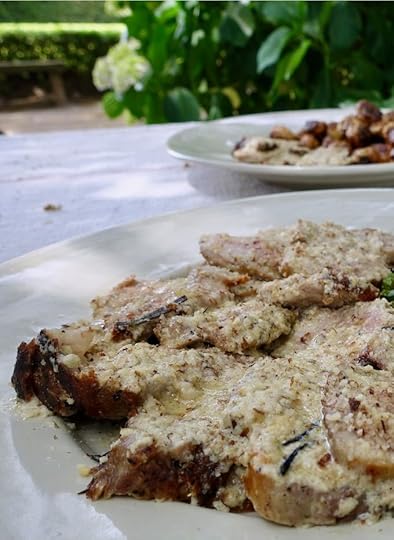
Pork Tenderloin with Hazelnuts
Yield 4
This recipe serves 4, and so uses 2 tenderloins which usually weigh about 1 pound each. If you’re making this for 1 or 2, just divide the recipe in half. And if you can’t find stracchino or crescenza, you can substitute mascarpone, although it may be a bit less sour. In this case a squeeze of lemon at the end would work
Ingredients
2 pounds pork tenderloin (2)
Salt
Pepper
2 Tablespoons chopped fresh Rosemary
1 cup whole milk
3 – 4 tablespoons Stracchino
3/4 cup toasted hazelnuts, roughly chopped
2 tablespoons olive oil
Instructions
You will probably have 2 tenderloins. Trim them of any visible fat. Wash and pat dry.
Remove rosemary leaves from woody stem, and chop. Use the rosemary , salt and pepper to season the pork. Cover in plastic wrap and let sit for 20-30 minutes.
Pour the olive oil into a heavy bottomed pan. Heat over medium high. Add the pork, which you have patted dry. Brown the pork well, on all sides, turning once one side is browed. Tip: when browning meat, wait to turn until the meat easily comes away from the bottom of the pan. This means it is fully browned. To not try to force it, or else bits will tear off and stick.
The browning / cooking should take about 30 minutes.
In the meantime roughly chop the hazelnuts.
When the meat is done browning, remove from the pan and place on a dish to rest for 15 minutes.
Turn the heat down to low, and add milk to pan. Using a wooden spoon, scrape up the browned bits form the bottom of the pan. When it comes to a simmer, and the bits are dissolved add the cheese. Stir, melting the cheese, and add 1/2 cup of the chopped nuts. Let the sauce simmer and thicken a bit. Don’t worry if the cheese looks a bit curdled and separates.
Finish the dish by cutting the tenderloin into 3/4 inch slices. Place the slices back into the pan with the sauce to re-heat. Do not over cook, and it is ok if the meat is pink. You don’t want to over cook the meat.
To serve, place on platter topped with the sauce from the pan, and top with the remaining nuts.
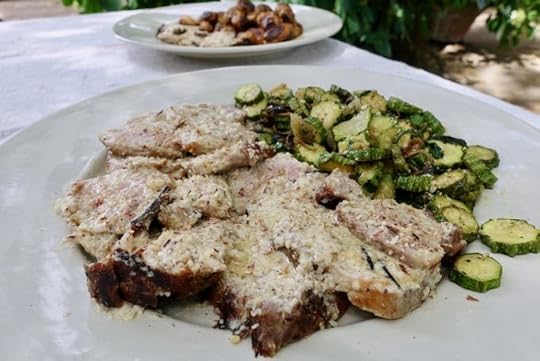
This recipe is an excerpt from my book The Italian Table.
If you’d like to join me in Italy this spring, we’ll be cooking and eating dishes like this during our two Week in Umbria Food Tours we have planned. You can find more information, including the dates, here.
The post Pork Tenderloin with Hazelnuts appeared first on Elizabeth Minchilli.


December 14, 2020
Ordering Coffee in Rome


If you follow me on Instagram it might seem like the only thing I do all day long is wander around drinking coffee. These days, that is pretty much spot on. I LOVE coffee, for many reasons. I of course love the pick me up it gives me, and the taste. But I also love the social aspect as well as the cultural interactions.
Yes, for me, each little cup carries a bit of culture with it. Where you drink it of course matters: there is an entire country between a Bicerin in Torino and an Espressino in Bari. Time of day too, makes the entire experience change. Are you standing at the bar with people on their way to work at 6am? Or are you bypassing the card playing old men lingering over their macchiato at 10:30?
I could go on and on (and I do in chapter 6 of my book, Eating Rome as well as on this radio show) but for now, I wanted to share a few of the more well known coffee drinks you can order next time you make it to Rome.
Caffè
This is what most people order. Otherwise known as an espresso (no ‘x’ in case you were following the current internet conversation). This is what most Romans head to their favorite bar to drink. Usually served in a heated, ceramic cup, the coffee is usually sipped (not gulped!) standing up, at the bar. To appear very Roman, order yours in vetro, in glass.
Caffè Macchiato
Stained coffee. Stained with milk, that is. A short shot of espresso with just a tiny drop of milk. If you want to get particular (and Romans are always so about their coffee) then specify if you’d like it macchiato caldo (hot) or macchiato freddo (cold). Or, you can be like my husband’s partner Corrado. He orders his tiepido. Yes. Tepid. Yuck.
Caffè Doppio
I’m pretty sure this double shot of espresso was invented for crazy Americans. Who have no regard for being careful of how much coffee they drink. I order this all the time. I especially like to order it in front of my husband, who is sure I will keel over and die from too much coffee.
Cappuccino
A shot of espresso topped with foamed, hot milk. Again, there are endless variations. For instance, a cappuccino senza schiuma. A cappuccino without foam. Not so sure what the point of that is, but it’s very popular.
Latte Macchiato
A big glass of warm milk, with just a dash of coffee to stain it, to take the warm milk taste away. I love latte macchiato, since it really is pure comfort food disguised as a coffee drink. In Rome most people consider this a drink for children, or if you’re feeling poorly. Or American.
Marocchino
This is a shot of espresso, a topping of hot, foamed milk and a generous sprinkling of cocoa. Since this is always served in a small glass, the milk-lightened coffee is on show. Hence the completely racially offensive name. (Although, I’ve also seen it called Moretto, which is as racially insensitive as Marocchino). In the south it’s called an Espressino, which is I think the name we should all adopt.
Monachella
This one is called Little Nun. Which is kind of cute. In this case it’s just like a marocchino, but the black coffee is wearing a wimple in the form of a dollop of whipped cream.
Caffè Shakerato
This is one of my favorite summer time coffee drinks. First of all, I love the name. Shakerato is just the Italianized version of shaken. In this drink a room temperature shot of espresso is poured into a cocktail shaker with ice and a bit of sugar. After about a minute of vigorous shaking, the creamy foamy cold coffee is poured into a stemmed glass.
Granita di caffè
Hard to include this treat in a discussion of coffee, since it’s more like having an ice cream. But the amount of caffeine and sugar in this one packs such a wallop, that it will keep you going much longer than any straightforward coffee drink. Granita di caffè is black sweetened coffee, that has been slowly frozen and broken up so that large frozen coffee crystals form. You order it at a bar and the barista will dig deep into a frozen container sunken into the counter to scoop up the icy treat. Your only decision will be whether to have whipped cream on top and bottom, or only on top.
Affogato
Just in case you happen to be in a gelateria that is also a coffee bar, or a coffee bar that is also a gelateria, get one of these. This is a shot of espresso into which a spoonful of gelato has been added. My favorite combo is with zabaione gelato, and there is a bar near the Pantheon (Fiocco di Neve) that specializes in this. But really? Feel free to make your own whenever you manage to get coffee and gelato on the table at the same time. Play with your food.
Caffè Corretto
“Corrected” coffee. Corrected with the addition of grappa that is. Or any other alcoholic beverage of your choice. In theory this is a morning pick-me-up, usually drunken by farmers or people working in the market who need something just a bit more than coffee to kick start their mornings. Why not?
Caffè Americano
This is the coffee that was invented to appease the tourists who come to Rome and can’t handle the intense little cups of espresso. It’s a shot of espresso, that is drawn out with extra water. So in the end, it’s kind of like drip coffee. And actually not that bad. And if you really want to drive your Italian friends crazy, order a caffè americano doppio. They may even call an ambulance just in case for fear you have overdosed on caffeine.
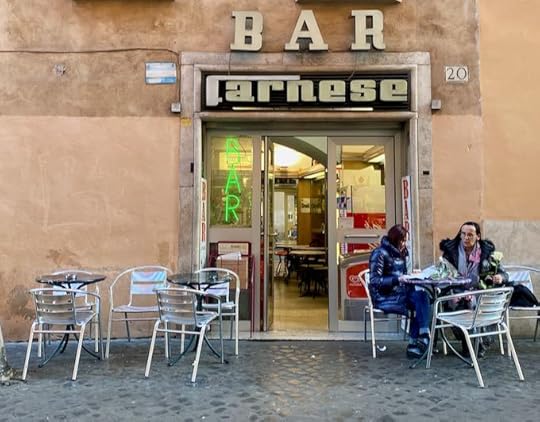

Macchiato

Caffè or espresso

Cappuccino in vetro

Macchiato


Granita

Affogato

Drip coffee which is almost non-existent in Rome, but which I make at home in the mornings and drink in my mug made by Sberna in Deruta
This is an excerpt from my book Eating Rome: Living the Good Live in the Eternal City
If you’d like to join me in Italy, drinking all kinds of coffee all over the place, you can. We host tours in Umbria, Puglia, Sicily, Abruzzo and Parma. You can find the full schedule here.
The post Ordering Coffee in Rome appeared first on Elizabeth Minchilli.


December 9, 2020
Radicchio + Tuna Pasta by Sophie
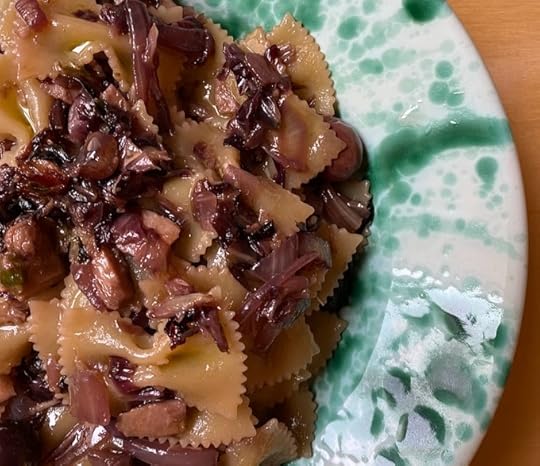 Guest Post by Sophie Minchilli:
Guest Post by Sophie Minchilli:
The other day I found myself at home for lunch, and starving (what else is new). However, I hadn’t planned on cooking anything for lunch, so I had to improvise. I knew I wanted a plate of pasta, so I checked my fridge and pantry to see what I could find to make the pasta dish extra delicious. This is what I found:
pasta
1 head of radicchio
1 small onion
1 can of tuna
a handful of black olives
olive oil
So Pasta with Radicchio seemed the obvious choice.
I had never made this dish, but somehow it’s these improvised ‘pantry meals’ that always turn out the best for me. Here is what I did with these ingredients. I guess I got very good at working with what I had during our time in Umbria last spring. We certainly never went hungry (!) but the added bonus was thinking up new combinations of ingredients that would never have occurred to us before.
So, radicchio, tuna, onions and olives? While I could have made a salad, isn’t pasta always the better answer to life’s questions?
Pasta with Radicchio & Tuna
Yield 2
I wouldn’t add any grated cheese on the pasta because of the tuna, but if you want cheese it can easily become a delicious vegetarian dish if you don’t use any tuna
Ingredients
250gr of pasta
1 head of radicchio
1 small onion
1/4 tsp salt
1 can of olive oil packed tuna
a handful of black olives
olive oil
Instructions
Start by putting a pot of water to boil. Once it boils, add a handful of coarse salt and then throw your pasta in.
Chop the onion in small pieces
Thinly slice the radicchio
Take the pits out of the olives
Add 1/4 cup of olive oil to a large sauté pan and let it warm up (about 30 seconds). Add the onion and let cook until softened and gold (about 1 minute).
Add the radicchio and salt and let cook until it wilts completely (about 5 minutes).
Lastly, add your can of tuna, with the oil from the can, and the olives and keep stirring them around the pan with the radicchio.
Drain your pasta when it’s about 2 minuted away from being al dente (reserve a full cup of the pasta cooking water) and add the pasta to the pan with the radicchio and tuna. Keep stirring it around the pan, while slowly adding some of the pasta cooking water. This will keep cooking the pasta while also making the ‘sauce’ more creamy. You probably won’t need the full cup.
Drizzle your best extra virgin oil and season with peperoncino (chili flakes)
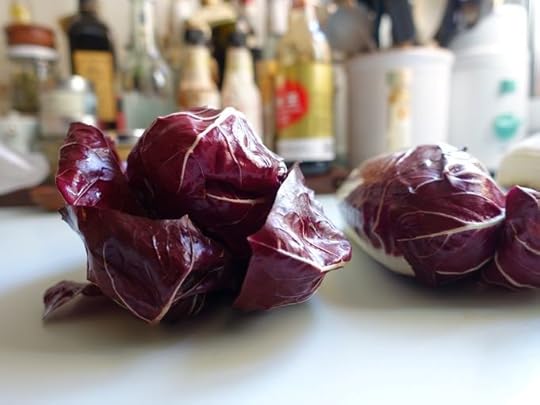
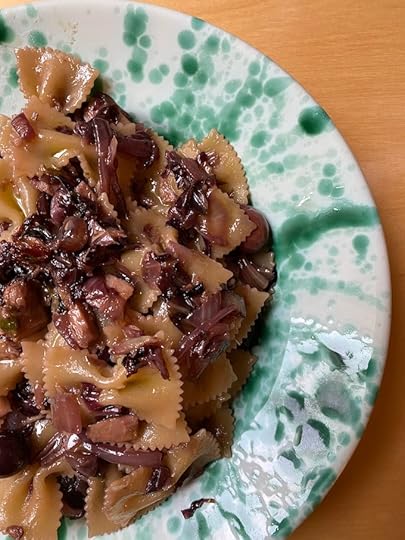
To see other recipes by Sophie visit her IGTV channel
And to find out more about Sophie’s market tours in Rome, visit her website
The post Radicchio + Tuna Pasta by Sophie appeared first on Elizabeth Minchilli.


November 15, 2020
Thanksgiving ideas 2020

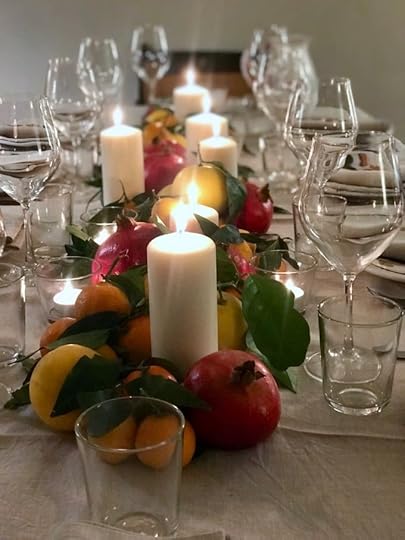
We don’t celebrate Thanksgiving every year. Since it’s not a holiday here in Italy it’s just usually not on my radar until the last minute. When the kids were little I made more of an effort, inviting friends from Rome up to our house in Umbria for the day and making a blowout feast for 10 to 20 people. In the last few years though, since the fall is usually such a busy time for me tour-wise, I just couldn’t be bothered. At the most I’d throw something together that involved pumpkin and call it a day.
This year though, I had actually been planning on at least inviting a few friends over. Now that Italy has returned into lockdown I’m not sure that will happen. One of my friends is in Tuscany, which I think means he won’t be able to travel to our region of Umbria. But I’m still hoping that the current rules will allow us to have at least a couple of neighbors over for a well-ventilated, socially distanced celebration of some sorts.
Because if nothing else 2020 is the year I am celebrating ALL of the holidays. I’m taking any chance I can get to light more candles and bring more cheer into our house. Because even if it’s only Sophie, Domenico and me around the table, I’m going to make special days special if there is even half a reason.
So what’s the menu this year? Definitely turkey, but not a mega bird. My local butcher is making me one of his special boned and stuffed turkey legs. I have a feeling there will be sausage and pancetta involved, so it will be kind of like a turkey version of porchetta.
I haven’t decided on the sides or desserts yet, but thought I’d share some of the recipes on my blog that I’m considering and that could maybe work for you. Because I hope you will be setting the table and lighting some candles even if it’s not the family and friends feast of years past. Don’t let 2020 blow out your candles
Cocktails
Pomegranate Cocktail
Red Currant and Grappa Cocktail
Negroni Sbagliato
Appetizers
Winter Squash Soup
Stuffed Onions
Celery & Cheese Salad
Vegetarian Mains
Pumpkin Risotto
Pumpkin Lasagna
Fennel Parmigiana
Sides
Baked Fennel & Pecorino
Rosemary Roast Potatoes
Roasted Butternut Squash with Sage Pesto
Salads
Radicchio & Pear Salad
Kale & Clementine Salad
Desserts
Persimmon-misu
Persimmon cream
Quince Crostata
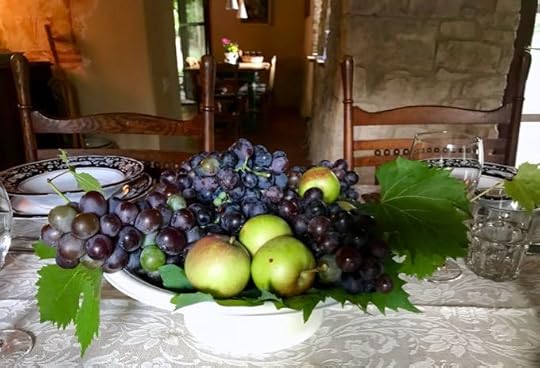
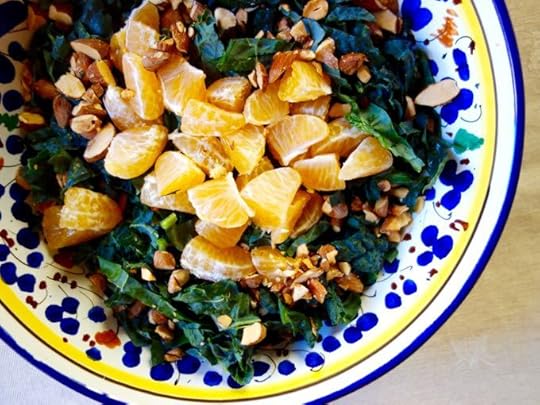
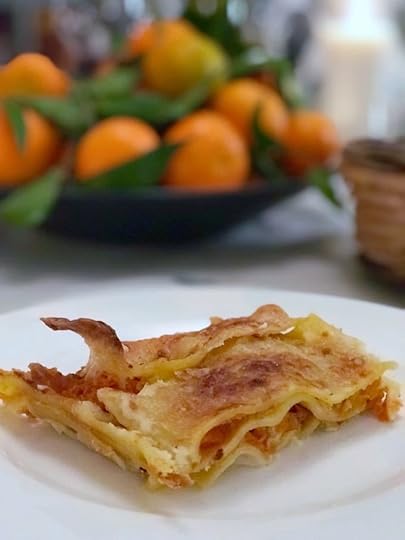
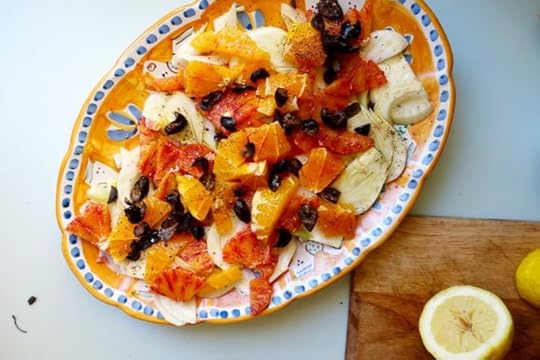
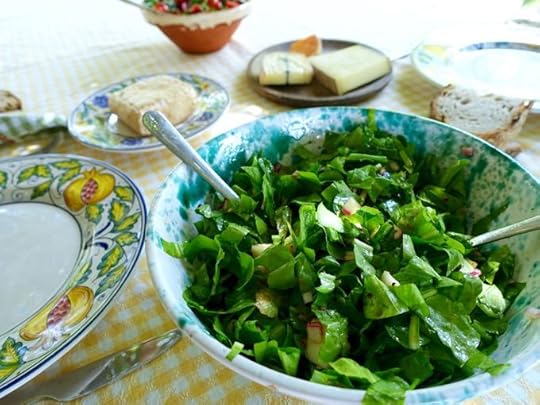
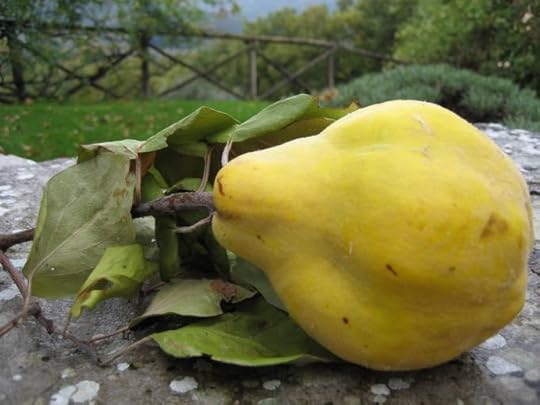
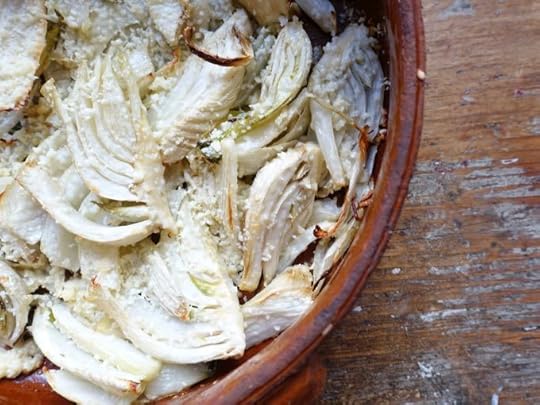
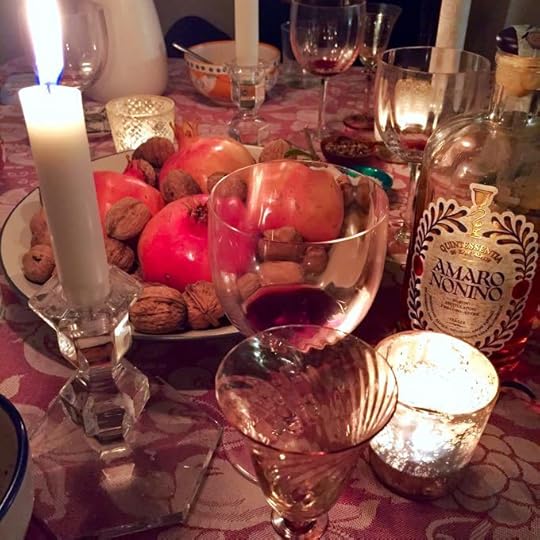
If you’re looking for more menu inspiration, recipes and even ideas about how to set your holiday table, you can find them in my book The Italian Table.
The post Thanksgiving ideas 2020 appeared first on Elizabeth Minchilli.


November 14, 2020
Books for the Holidays
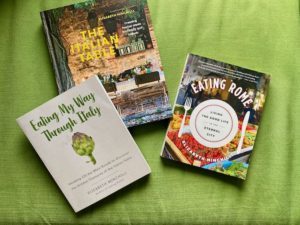
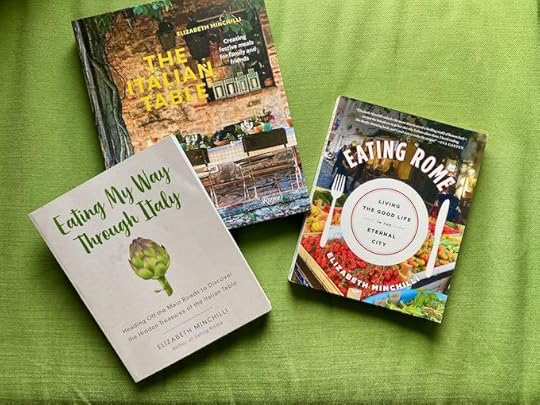
I decided that this year I was going to my holiday shopping early. And by early I mean now. Because let’s face it, I do have time on my hands. Also? Rather than squirrel away gifts, or schedule them for delivery closer to the holidays I’ve decided to hell with that. I’m also sending my gifts now! Because if my friends and family are like me, then a little unexpected early gift may be just the thing they need. Right?
So if you’re thinking the same thing, might I humbly suggest a copy of one of my books? In these days when travel is off the table, what better way to bring a bit of Italy into your home than by literally putting it on the table?
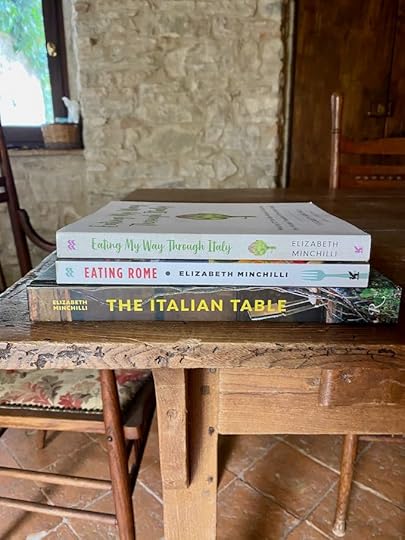
The Italian Table: Creating Festive Meals for Family and Friends (Rizzoli 2019)
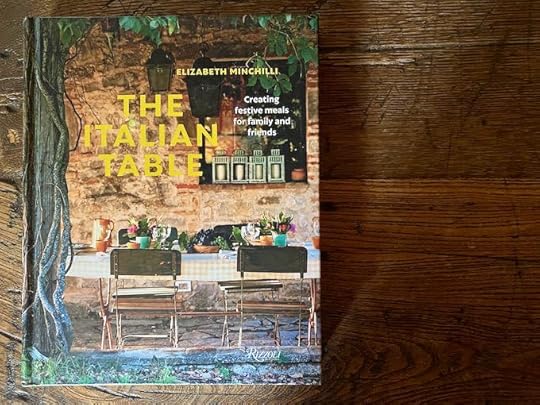
My most recent book was published last year. The Italian Table delivers both the fantasy and the reality of Italian meals as they would be eaten on location. Combining menus and recipes with visual experience and inspiration–as well as insight into the traditions of the food and celebrations–it serves as a practical resource that gives home cooks and hosts step-by-step guidance on how to re-create these fabulous meals at their own tables.
“I want to cook every one of Elizabeth’s recipes and, even more, I want to move to Rome and spend my afternoons listening to her stories over Campari spritzes! This book is filled with delicious recipes plus brilliant ideas for menus, table settings, and wine pairing to create the perfect Italian table, no matter where you live. What a beautiful, romantic and incredibly useful book!” – Ina Garten, Barefoot Contessa cookbooks and TV
Eating My Way Through Italy: Heading Off the Main Roads to Discover the Hidden Treasures of the Italian Table (St. Martins 2018)
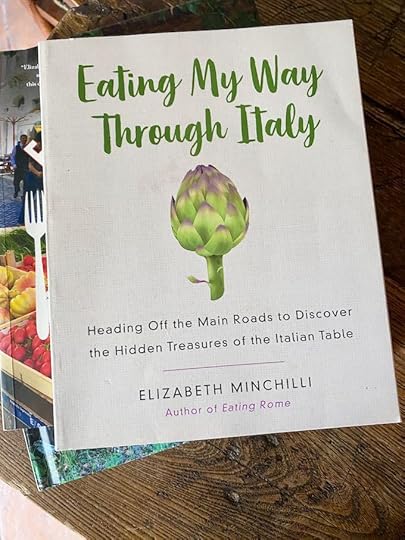
Divided geographically, Eating My Way Through Italy looks at all the different aspects of Italian food culture. Whether it’s pizza in Naples, deep fried calamari in Venice, anchovies in Amalfi, an elegant dinner in Milan, gathering and cooking capers on Pantelleria, or hunting for truffles in Umbria each chapter includes, not just anecdotes, personal stories and practical advice, but also recipes that explore the cultural and historical references that make these subjects timeless
“Discovering Italy is all about traveling through the back roads and sitting down at the table with Italians. That is exactly what Elizabeth has done for her new book; she takes you to beautiful hidden gems all over Italy. She guides you regarding what not to miss and what to locally eat and where to eat it. On top of that , she scattered delicious regional recipes throughout the book. Eating My Way Through Italy is a savory book onItaly, one that you will take with you on your next trip to italy and to y9our kitchen when you long for those Italian flavors at home.” – Lidia Bastianich, chef/restauranteur and host of public televisions Lidia’s Table.
Eating Rome: Living the Good Life in the Eternal City (St. Martins 2015)
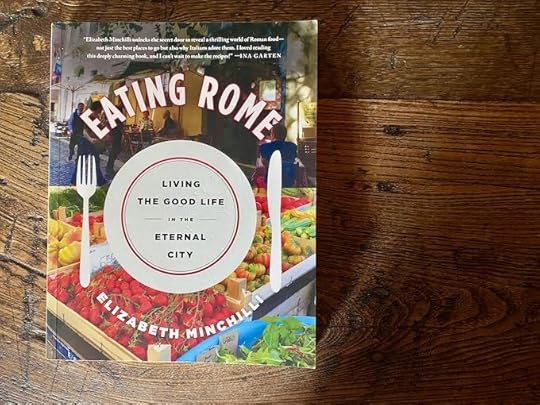
I’ve been eating my way through Rome since I was 12 years old. Eating Rome is my homage to the city that feeds me, literally and figuratively. My story is a personal, quirky and deliciously entertaining look at some of the city’s monuments to food culture. Join me as I take you on a stroll through my favorite open air markets; stop by the best gelato shops; order plates full of carbonara and finish the day with a brilliant red Negroni. Coffee, pizza, artichokes and grappa are starting points for mouth-watering stories about this ancient city. Illustrated with my full-color photos and enriched with my favorite recipes for Roman classics like vignarola, carciofi alla romana and carbonara, Eating Rome is the book that you want if you are planning your first trip to Rome or if you have been to Rome a dozen times or if you simply want to visit the city virtually.
“A true insider’s culinary guide to Rome. Elizabeth Minchilli takes us into the city’s trattorias, cafes, pizzerias, and gelaterias. Each time I’ve been to Rome, I’ve turned to Elizabeth for advice and have never been steered wrong.. In Eating Rome, she generously shares all she loves about this delicious city, including recipes and favorite addresses, with everyone, and makes me hungry to go back. In fact, after reading these pages, if you’re anything like me, you’ll be ready to book a flight to Rome — pronto!” – David Lebovitz, chef, blogger and cookbook author
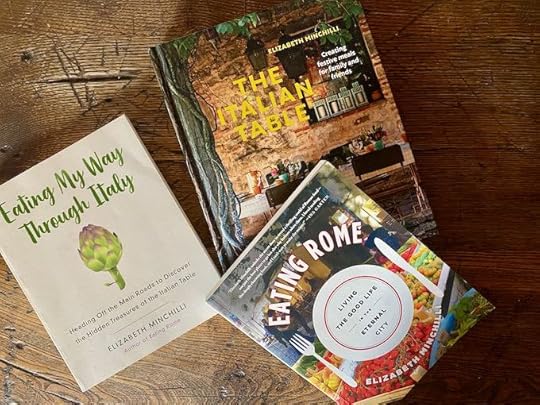
I’ve provided links above through Amazon (and I also get a bit of a commission ) but I’d also be thrilled if you ordered any or all of these books through your favorite independent bookstore. Here are the publishers book links, that will lead you to alternative ways to order:
The Italian Table
Eating My Way Through Italy
Eating Rome
And here are some of my favorite independent small bookshops that will be happy to send copies of these books anywhere you’d like:
Barrington Books, Rhode Island
Ominvore Books, San Francisco
Left Bank Books , St Louis
Now Serving, LA
Book Passage, San Francisco & Bay Area
Rakestraw Books, Danville (Bay Area)
Book Larder, Seattle
I Am Books, Boston
One final endorsement from Kitty who suggests you pile up all three books in a window seat and then take a nap.
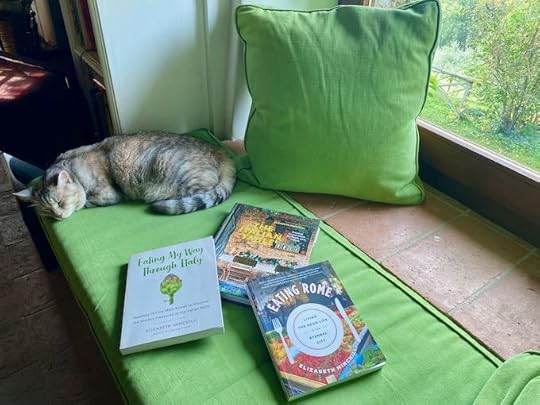
The post Books for the Holidays appeared first on Elizabeth Minchilli.


November 9, 2020
pumpkin risotto
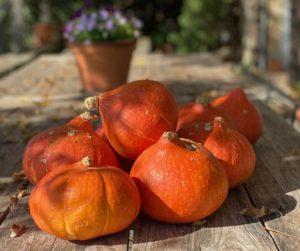
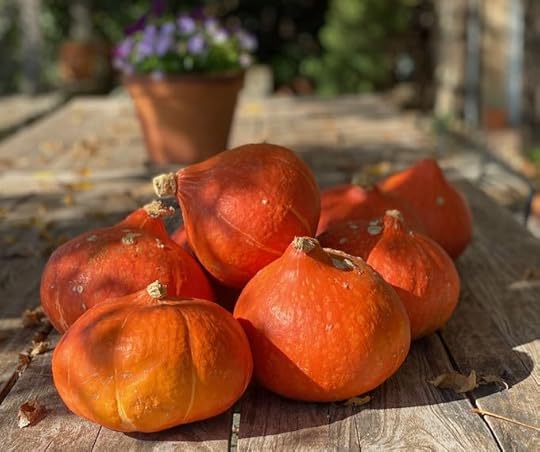
I’m a sucker for a pumpkin. And when I say pumpkin, I’m including the entire gourd and winter squash family. Bumpy decorative gourds, butternut squash, big as your head Halloween pumpkins. If it’s vaguely fall like, and for sale, chances are I will bring it home with me.
We managed to grow 4 edible squashes this year in our garden. They take up so much room, and require so much water, that we were lucky to get even that. But thank goodness my local stores carry them, and my friends gift them to me. So our house is filled to the brim with orange, green, yellow and even gray orbs.
Since this year I’m taking ALL holidays very seriously (what else is there to do?) Halloween was no exception. Especially since this holiday allows me to indulge in both the decorative and edible possibilities of my pumpkin obsession. For decorative purposes I decided we should have a jack’o lantern competition. And so was able to justify four pumpkins coming home with me from the supermarket.
On the edible side of things I picked up some nutella-stuffed pumpkin cookies at the local bakery because why not? But I also used one of the gorgeous Hokkaido squashes that my friends Thomas and Lisbeth gave me. They had originally special ordered 8 of them for a cooking class that got cancelled because of the current lockdown. So I was happy to be the recipient of their gourd overload!
I decided to make risotto with it. I’d been craving risotto and Halloween seemed the perfect excuse. While I used a Hokkaido, which has bright orange flesh, a compact texture and a nutty flavor, you can also use butternut for this recipe. Or any other edible squash you have (I made it with this one here). FYI: While the big orange pumpkins used for jack’o lanterns are in theory edible, they are rarely grown organically and their flesh is pretty tasteless and watery. So avoid those.
This would obviously make a great first course for Thanksgiving, or even main course if you aren’t doing Turkey. If you’re looking for other pumpkin recipes here they are.
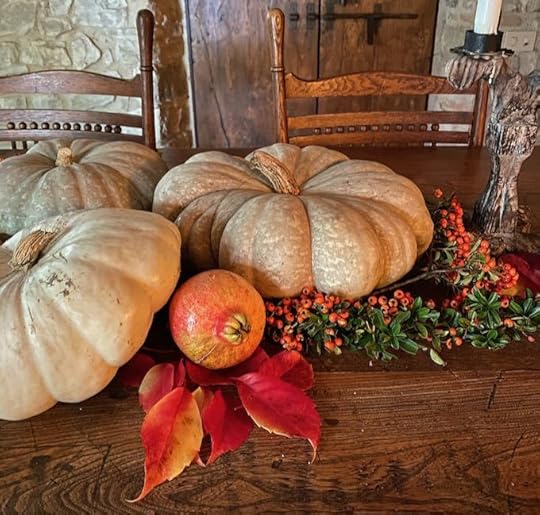
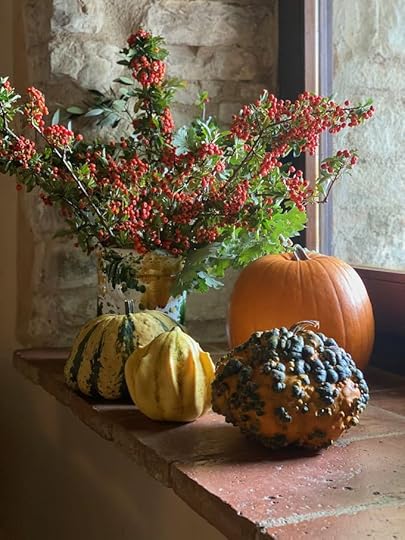

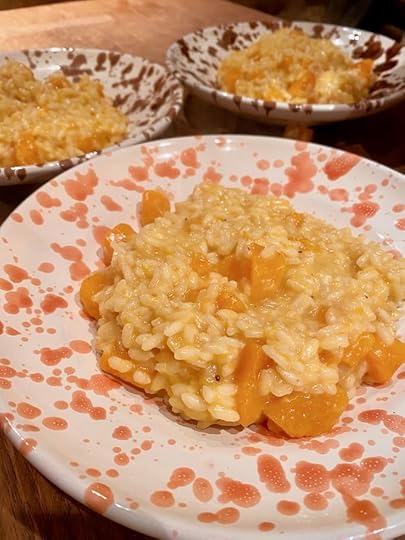
Pumpkin Risotto
Yield 5-6
Ingredients
2 tablespoons olive oil
5 tablespoons butter
1 medium onion
Salt
Pepper
1 medium size winter squash, peeled and cut into small cubes (you should have about 5 cups of cubed squash)
500 grams / 1 pound arborio rice
1 glass of white wine
4-6 cups vegetable or chicken broth
1 cup grated parmigiano reggiano
1/2 cup grated mild hard pecorino or goat cheese
Instructions
Place a large pot over low heat and add 2 tablespoons of butter and olive oil. Once it is melted, add the onion and season with salt and pepper. Let soften for about 6 minutes.
In the meantime bring broth to a low simmer
Turn the heat to medium low. Add half of the squash, stir and let cook for about 10 minutes, until the squash starts to soften. Add the rice and stir for about 4 minutes.Add the wine and let that evaporate.
Add the rest of the squash, stir and add about 4 ladles of hot broth. Stir and keep cooking and adding the broth slowly, as the rice absorbs it. Keep doing this until the rice is almost done. I like mine a bit al dente, but it’s up to personal taste.
Turn off the heat, and add the remaining butter, stirring to help the butter melt. This also helps to finish cooking the rice. Next add the two cheese, one after the other, stirring.
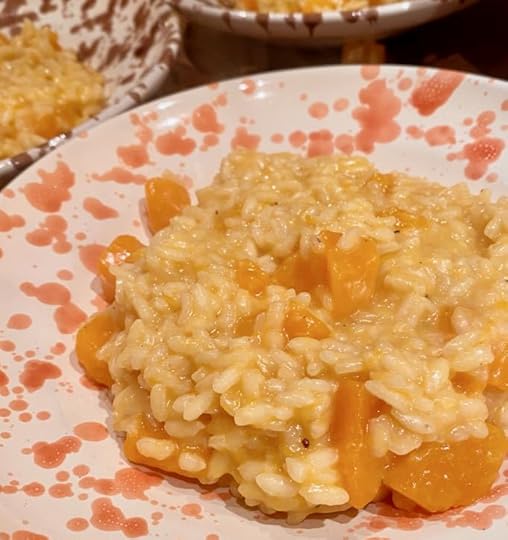

Would you like to join us in Umbria next year? We’ll be leading Week in Umbria food tours starting in May 2021. Here is the full schedule.
The post pumpkin risotto appeared first on Elizabeth Minchilli.


October 14, 2020
Stuffed Celery + Celery Pesto
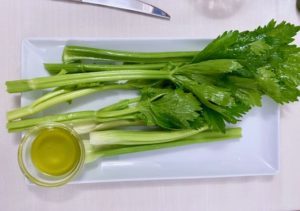
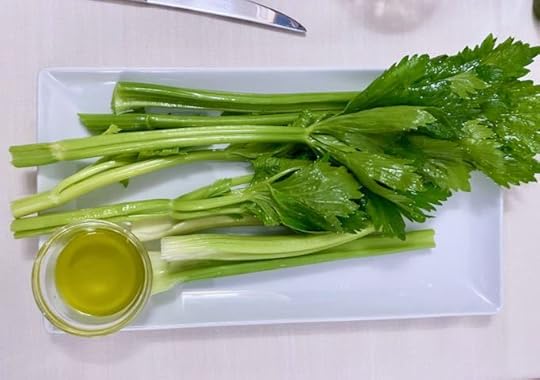
How many ways can you eat celery? A LOT as it turns out. Although I’ve always been a huge fan of celery (and use it as the base for some of my favorite salads) last week I learned that cooked celery, playing the starring role in main dishes like stuffed celery and celery pesto, is not only a good thing, it’s a great thing.
I’d known about the famous Sedano Nero of Trevi for a while now. Black Celery of Trevi is a specific variety of celery that only grows in the plains surrounding the town of Trevi, along the fertile banks of Clitunno river, in Umbria. The first thing I learned is that while it’s called ‘Black’ celery, it’s as green as any celery you’ve ever seen. The black refers to the color of the seeds. Regular celery seeds are brown, in case you were wondering.
What makes the celery different from other varieties is that it is more tender and has less strings. This is partly to do with the nature of the plant, but also the fact that they wrap up the bunches in paper to blanch them, making the heart and inner stalks even sweeter. This means that they can be cooked up in to all sorts of dishes. Sedano Nero di Trevi used to be prized all over Italy for it’s intense flavor and tenderness but once new varieties were introduced after WWII, it fell out of favor. One of the reasons was that the stalks grow incredibly long, up to a meter (3 feet!) in length. This can be a bit unwieldy (see the awkward photo of me holding my bunch below) Luckily today Sedano Nero has been recognized as a prized heirloom variety and the yearly festival organized by the town of Trevi has made it a bit more well known. Still, it’s almost impossible to find it outside of this small area.
While I’ve visited Trevi dozens of times to go truffle hunting, the elusive celery has always remained just beyond reach since it’s only in season a few weeks a year. This year I was determined to attend the festival.
Well, you know how this year’s going. Not so festive. In fact, the usually bustling festival which takes over the main square of Trevi was basically just a few stands. But that didn’t stop me! I bought an armload of celery not quite knowing what I’d do with it, then headed to a local restaurant to eat my way through their celery menu.
Since the celery has less strings and is both sweeter and more intense tasting than normal celery, this means that they can be cooked up in to all sorts of dishes.
We started out simple, with pinzimonio, or crudite. Luckily the celery harvest always coincides with the first press of new olive oil, so we happily dipped our crispy stalks into bright green bowls of olive oil that has been pressed the day before.
This was by far the lightest dish we had. As it turns out the best way to enjoy celery – at least in Trevi – is with heaping quantities of cream and cheese, with sausage often thrown in for good measure. But hey, it was a rainy cold October day, and I’m telling you this kind of food was exactly what we were craving.
Trucioli al pesto di sedano e gorgonzola was a plate full of curly pasta covered in a creamy pesto of celery blending with melty gorgonzola. We also had the Lasagna con Sedano, Salsiccia e Gorgonzola which was definitely up there with the best idea for lasagna I’ve ever eaten. Home made pasta was layered with sausage and gorgonzola with chunks of tender celery throughout.
Finally the main dish that we had actually come here for. All of the other dishes were welcome surprises, but the famous Sedano di Trevi Ripieno al Ragu was something I’d been dreaming about since I first heard about it a few years ago. This multi step recipe is a labor of love. The head of celery is trimmed, washed, boiled, dried, stuffed with sausage, tied up, coated in batter, fried, covered with ragu, and then put in the oven, cut in half, covered with more ragu and cheese and butter and then put back in the oven.
It was INSANE.
If this dish doesn’t convince you that celery needs to be in the center of the table I don’t know what will.
I’m going to try to recreate the stuffed celery recipe using normal celery soon, since I know that you can’t get your hands on Sedano Nero. Once I do I’ll make a video to show you how it’s done. In the meantime I’ll leave you with this recipe which is slightly easier to recreate at home, Celery Leaf Pesto. The trick is getting your hands on a fresh bunch of celery with the leaves still attached. In Trevi, during the festival, that’s not a problem. I hope you can find some in your local farmers market.
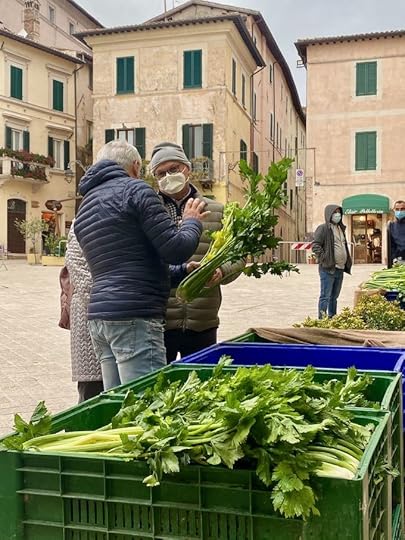
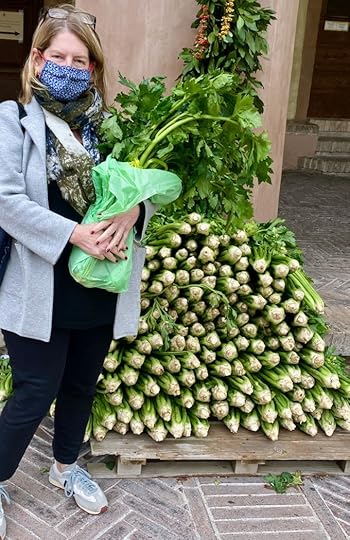
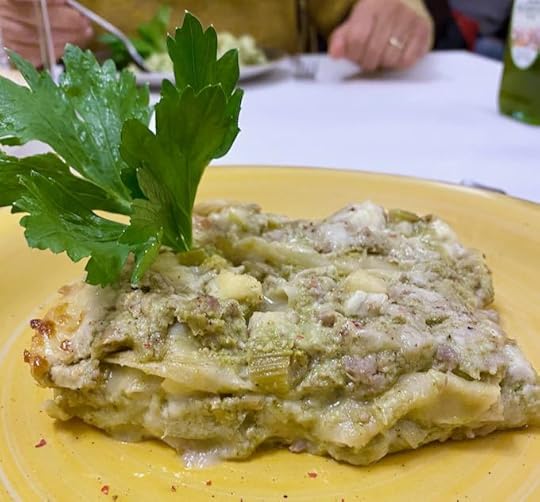
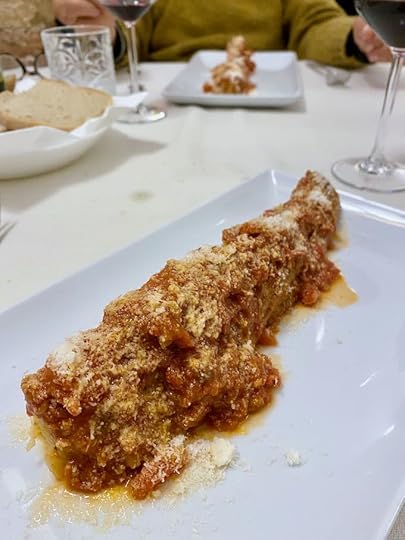
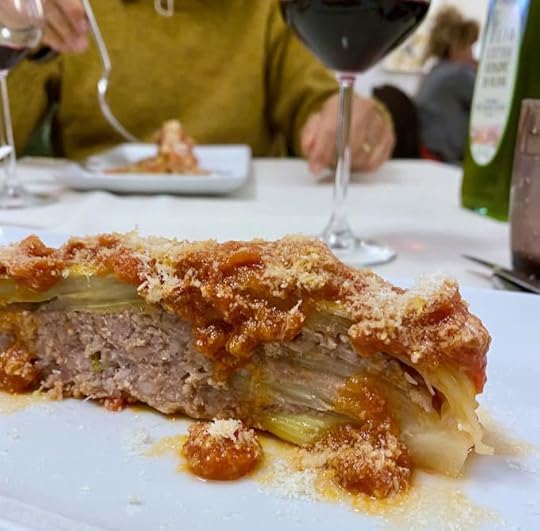
Celery Leaf Pesto
Yield 5
This is based on the dish I had at Maggiolini in Trevi. They served it over a pasta shape called trucioli that kind of look like curly half rigatoni. This is a good dish to make when you get a really great head of celery that still has the leaves on it.
Ingredients
2 cups celery leaves
pinch salt
grinding of black pepper
1/3 cup pine nuts
2 cloves garlic
1/2 cup extra virgin olive oil
pinch salt
1/4 cup grated parmigiano reggiano (or grana)
100 grams gorgonzola dolce, but into cubes
1 pound / 500 gr pasta
Instructions
Place the celery leaves in a food processor along with the pine , salt, pepper and garlic. Blend until finely chopped. Scrape down the sides if you have to.
With the motor running, pour in the olive oil. Mix until it is well pureed. Again, you may have to scrape down the sides.
Next add the parmigiano and mix again. Then add the gorgonzola. Depending on the consistency of the gorgonzola it might glop up a bit. Don’t worry.
Scrape the pesto into a small bowl and cover with plastic wrap with the wrap touching the top of the pesto.( If you make the pesto ahead of time, store in the refrigerator, but make sure it comes back to room temperature before using.)
Boil the pasta in salted water until cooked. Drain, reserving a cup of the pasta cooking water. Put the pasta back into the warm pot where you cooked the pasta and add the pesto. Stir well and fast, using the reserved pasta water to loosen it up. Just add a bit of water at a time, not too much and certainly not all of it.
Serve. It shouldn’t need more grated parmigiano, but freshly grated black pepper is perfect.
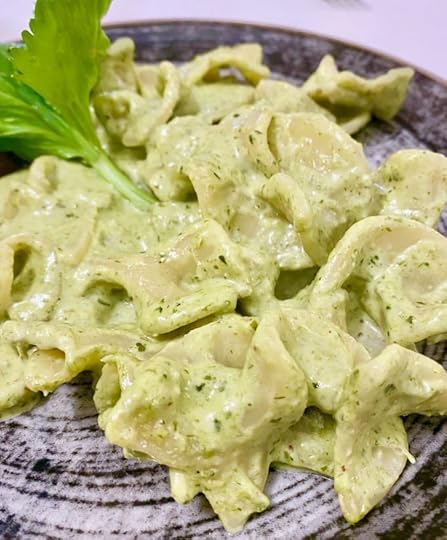
The Festa del Sedano Nero takes place in Trevi, Umbria the second and third weekend of October. There is usually a large market place in the town square, along with an outdoor restaurant that serves celery and sausage dishes. This year’s festa was much reduced, but most of the restaurants serve dishes featuring the celery.
Ristorante Maggiolini
Via S. Francesco 20
Trevi
+39.0742.381.534
Located right in historic center of town, this restaurant specializes in fish, including local trout. But they also have abundant truffle and celery dishes in season.
Terziere
Via Coste 1
Trevi
+39.0742.78359
This elegant restaurant is located in a small hotel just outside the city center. Gorgeous views and great food, including a special seasonal celery menu.
During our Week in Umbria Food Tour we always visit Trevi and taste their local specialties, including truffles and olive oil. If you’d like to join us for our upcoming trips in 2021 and 2022, we’d love to see you! Visit this page for our current schedule of tours, or else send me an email.
The post Stuffed Celery + Celery Pesto appeared first on Elizabeth Minchilli.





